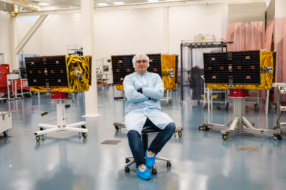Starfish Space has revealed its plans for its first space mission in spring 2023. The mission will demonstrate the startup’s satellite docking technology through its Otter Pup spacecraft, and if successful, it will be the first ever satellite docking using electric propulsion.
Starfish 101: The Seattle-based startup has ambitions to enable an in-space economy where inexpensive, easily accessible in-orbit servicing is the norm.
“You can drive your car until the wheels literally fall off. But you can do that because you can go and take it to a mechanic if you need to, or you have a tow truck to get you out of the way in traffic,” Starfish cofounder Trevor Bennett told Payload.
“That’s the reliance that we need in space. We have to have the comfort that it will always be there, ready when you need it.”
To date, satellite docking experiments have cost hundreds of millions of dollars. Starfish says they can accomplish the task for far cheaper (the company has raised ~$8M in VC to date and won a handful of NASA and DoD contracts). In order to bring costs down, Bennett said its servicer will have to be three things:
- Autonomous. “There’s a model right now where it takes 100 people to operate one satellite. Let’s get that to one person operating 100 satellites, and constellation operators think about this on a day to day basis,” Bennett said. “But can we do that for the tow trucks? Can we do that for the servicers?”
- Software-driven. “In general, software can develop faster, it can iterate faster, it can also be just a more affordable way than having to build custom hardware,” Bennett said.
- Mostly off-the-shelf. Besides the custom-built capture system, Nautilus, Otter Pup is entirely made from off-the-shelf hardware.
More on Otter Pup: The company’s demonstration mission is slated to launch on Transporter-8 in mid-2023. The mission will deploy Otter Pup, a small test satellite, from Launcher’s Orbiter craft. Otter Pup will keep a safe distance from Orbiter, then slowly draw closer and closer before performing a series of docking maneuvers.
The demonstration will test the three core technologies that Starfish will need before it can build its full servicer, Otter:
- Nautilus, the electrostatic docking mechanism
- Cephalopod, the guidance control software
- Cetacean, the relative navigation software
Combined, these three technologies will enable the company to continue building Otter, the full-size servicer. Starfish is targeting late 2024 or 2025 for the first Otter mission.




